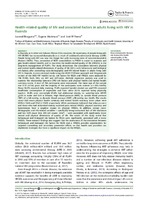| dc.contributor.author | Biraguma, Juvenal | |
| dc.contributor.author | Mutimura, Eugene | |
| dc.contributor.author | Frantz, Jose M. | |
| dc.date.accessioned | 2018-10-15T12:38:16Z | |
| dc.date.available | 2018-10-15T12:38:16Z | |
| dc.date.issued | 2018 | |
| dc.identifier.citation | Biraguma, J. et al. (2018). Health-related quality of life and associated factors in adults living with HIV in Rwanda. SAHARA-J: Journal of Social Aspects of HIV/AIDS, 15(1): 110-120 | en_US |
| dc.identifier.issn | 1729-0376 | |
| dc.identifier.uri | http;//dx.doi.org/10.1080/17290376.2018.1520144 | |
| dc.identifier.uri | http://hdl.handle.net/10566/4123 | |
| dc.description.abstract | In Rwanda, as in other sub-Saharan African (SSA) countries, life expectancy of people living with HIV (PLWH) has increased dramatically as a result of combined antiretroviral therapy (cART). People living with HIV can now live longer but with increasing rates of non-communicable diseases (NCDs). Thus, prevention of NCD comorbidities in PWLHI is crucial to maintain and gain health-related benefits and to maximise the health-related quality of life (HRQOL) in the long-term management of PLWH. This study determines the association between physical and mental health-related dimensions of quality of life (QOL) with behavioural and biological risk factors, after controlling socio-demographic and HIV-related factors in adults living with HIV in Rwanda. A cross-sectional study using the WHO STEPwise approach and Kinyarwanda version of the MOS-HIV Health Survey, risk factors for NCDs and HRQOL were analysed for 794 PLWH, both HIV+ on ART and ART-naïve. Multiple regression analysis was used to examine the relationship between CMD risk factors and physical health and mental health summary scores. A total of 794 participants were interviewed. The mean age of the sample was 37.9 (±10.8) years and the majority of the participants were women (n = 513; 64.6%). About 16.2% reported daily smoking, 31.4% reported harmful alcohol use and 95% reported insufficient consumption of vegetables and fruits while 26.1% reported being physically inactive. 18.4% were overweight 43.4% had abdominal obesity, i.e. waist-hip-ratio (WHR) ≥0.95 in males and 0.85 in females. High blood pressure (HBP), i.e. systolic blood pressure (SBP) of ≥140 mmHg, or diastolic blood pressure (DBP) ≥90 mmHg was 24.4%. The results reveal that mean physical health summary and mental health summary score values were 63.96 ± 11.68 and 53.43 ± 10.89, respectively. While participants indicated that tobacco users and those who had abdominal obesity reported poor mental HRQOL, physical inactivity and hypertension have a negative impact on physical HRQOL. In addition, certain sociodemographic and HIV-related variables – specifically being unmarried, lack of HIV disclosure and low CD4 count (less 350 cell counts /mm3) – were associated with significantly lower mental and physical dimensions of quality of life. The results of this study reveal that behavioural and biological risk factors for NCDs were significantly associated with a lower HRQOL. These research findings also suggest that the assessment of the association between behavioural and biological risk factors for NCDs and a HRQOL provides opportunities for targeted counselling and secondary prevention efforts, so that health care providers can implement strategies that have a significant impact on the HRQOL. | en_US |
| dc.language.iso | en | en_US |
| dc.publisher | Taylor & Francis | en_US |
| dc.rights | Copyright, 2018: the Authors. This is an Open access article distributed under the terms of the Creative Commons Attribution License. | |
| dc.subject | Non-communicable diseases | en_US |
| dc.subject | Risk factors | en_US |
| dc.subject | HIV | en_US |
| dc.subject | Health related quality of life | en_US |
| dc.subject | Physical health | en_US |
| dc.subject | Rwanda | en_US |
| dc.title | Health-related quality of life and associated factors in adults living with HIV in Rwanda | en_US |
| dc.type | Article | en_US |
| dc.privacy.showsubmitter | FALSE | |
| dc.status.ispeerreviewed | TRUE | |
| dc.description.accreditation | DHET | |

